
Bayesian data analysis
正版图书 真实库存欢迎选购 套装图书先联系再下单 套装图书请先咨询客服再下单
¥ 98.26 5.8折 ¥ 169 全新
库存2件
作者Andrew Gelman[等著]
出版社世界图书出版有限公司北京分公司
ISBN9787519261818
出版时间2020-06
装帧平装
开本16开
定价169元
货号9819017
上书时间2024-10-25
- 在售商品 暂无
- 平均发货时间 24小时
- 好评率 暂无
- 最新上架
商品详情
- 品相描述:全新
- 商品描述
-
目录
Preface
Part I: Fundamentals of Bayesian Inference
1 Probability and inference
I.I The three steps of Bayesian data analysis
1.2 General notation for statistical inference
1.3 Bayesian inference
1.4 Discrete examples: genetics and spell checking
1.5 Probability as a measure of uncertainty
1.6 Example: probabilities from football point spreads
1.7 Example: calibration for record linkage
1.8 Some useful results from probability theory
1.9 Computation and software
I.I0 Bayesian inference in applied statistics
i.Ii Bibliographic note
1.12 Exercises
2 Single-parameter models
2.1 Estimating a probability from binomial data
2.2 Posterior as compromise between data and prior information
2.3 Summarizing posterior inference
2.4 Informative prior distributions
2.5 Normal distribution with known variance
2.6 Other standard single-parameter models
2.7 Example: informative prior distribution for cancer rates
2.8 Noninformative prior distributions
2.9 Weakly informative prior distributions
2.10 Bibliographic note
2.11 Exercises
3 Introduction to multiparameter models
3.1 Averaging over nuisance parameters
3.2 Normal data with a noninformative prior distribution
3.3 Normal data with a conjugate prior distribution
3.4 Multinomial model for categorical data
3.5 Multivariate normal model with known variance
3.6 Multivariate normal with unknown mean and variance
3.7 Example: analysis of a bioassay experiment
3.8 Summary of elementary modeling and computation
3.9 Bibliographic note
3.10 Exercises
4 Asymptotics and connections to non-Bayesian approaches
4.1 Normal approximations to the posterior distribution
4.2 Large-sample theory
4.3 Counterexamples to the theorems
4.4 Frequency evaluations of Bayesian inferences
4.5 Bayesian interpretations of other statistical methods
4.6 Bibliographic note
4.7 Exercises
5 Hierarchical models
5.1 Constructing a parameterized prior distribution
5.2 Exchangeability and hierarchical models
5.3 Bayesian analysis of conjugate hierarchical models
5.4 Normal model with exchangeable parameters
5.5 Example: parallel experiments in eight schools
5.6 Hierarchical modeling applied to a meta-analysis
5.7 Weakly informative priors for variance parameters
5.8 Bibliographic note
5.9 Exercises
Part II: Fundamentals of Bayesian Data Analysis
6 Model checking
6.1 The place of model checking in applied Bayesian statistics
6.2 Do the inferences from the model make sense?
6.3 Posterior predictive checking
6.4 Graphical posterior predictive checks
6.5 Model checking for the educational testing example
6.6 Bibliographic note
6.7 Exercises
? Evaluating, comparing, and expanding models
7.1 Measures of predictive accuracy
7.2 Information criteria and cross-validation
7.3 Model comparison based on predictive performance
7.4 Model comparison using Bayes factors
7.5 Continuous model expansion
7.6 Implicit assumptions and model expansion: an example
7.7 Bibliographic note
7.8 Exercises
8 Modeling accounting for data collection
8.1 Bayesian inference requires a model for data collection
8.2 Data-collection models and ignorability
8.3 Sample surveys
8.4 Designed experiments
8.5 Sensitivity and the role of randomization
8.6 Observational studies
8.7 Censoring and truncation
8.8 Discussion
8.9 Bibliographic note
8.10 Exercises
9 Decision analysis
9.1 Bayesian decision theory in different contexts
9.2 Using regression predictions: survey incentives
9.3 Multistage decision making: medical screening
9.4 Hierarchical decision analysis for home radon
9.5 Personal vs. institutional decision analysis
9.6 Bibliographic note
9.7 Exercises
Part III: Advanced Computation
10 Introduction to Bayesian computation
10.1 Numerical integration
10.2 Distributional approximations
10.3 Direct simulation and rejection sampling
10.4 Importance sampling
10.5 How many simulation draws are needed?
10.6 Computing environments
10.7 Debugging Bayesian computing
10.8 Bibliographic note
10.9 Exercises
11 Basics of Markov chain simulation
11.1 Gibbs sampler
11.2 Metropolis and Metropolis-Hastings algorithms
11.3 Using Gibbs and Metropolis as building blocks
11.4 Inference and assessing convergence
11.5 Effective number of simulation draws
11.6 Example: hierarchical normal model
11.7 Bibliographic note
11.8 Exercises
12 Computationally efficient Markov chain simulation
12.1 Efficient Gibbs samplers
12.2 Efficient Metropolis jumping rules
12.3 Further extensions to Gibbs and Metropolis
12.4 Hamiltonian Monte Carlo
12.5 Hamiltonian Monte Carlo for a hierarchical model
12.6 Stan: developing a computing environment
12.7 Bibliographic note
12.8 Exercises
13 Modal and distributional approximations
13.1 Finding posterior modes
13.2 Boundary-avoiding priors for modal summaries
13.3 Normal and related mixture approximations
13.4 Finding marginal posterior modes using EM
13.5 Conditional and marginal posterior approximations
13.6 Example: hierarchical normal model (continued)
13.7 Variational inference
13.8 Expectation propagation
13.9 Other approximations
13.10 Unknown normalizing factors
13.11 Bibliographic note
13.12 Exercises
Part IV: Regression Models
14 Introduction to regression models
14.1 Conditional modeling
14.2 Bayesian analysis of classical regression
14.3 Regression for causal inference: incumbency and voting
14.4 Goals of regression analysis
14.5 Assembling the matrix of explanatory variables
14.6 Regularization and dimension reduction
14.7 Unequal variances and correlations
14.8 Including numerical prior information
14.9 Bibliographic note
14.10 Exercises
15 Hierarchical linear models
15.1 Regression coefficients exchangeable in batches
15.2 Example: forecasting U.S. presidential elections
15.3 Interpreting a normal prior distribution as extra data
15.4 Varying intercepts and slopes
15.5 Computation: batching and transformation
15.6 Analysis of variance and the batching of coefficients
15.7 Hierarchical models for batches of variance components
15.8 Bibliographic note
15.9 Exercises
16 Generalized linear models
16.1 Standard generalized linear model likelihoods
16.2 Working with generalized linear models
16.3 Weakly informative priors for logistic regression
16.4 Overdispersed Poisson regression for police stops
16.5 State-level opinons from national polls
16.6 Models for multivariate and multinomial responses
16.7 Loglinear models for multivariate discrete data
16.8 Bibliographic note
16.9 Exercises
17 Models for robust inference
17.1 Aspects of robustness
17.2 Overdispersed versions of standard models
17.3 Posterior inference and computation
17.4 Robust inference for the eight schools
17.5 Robust regression using t-distributed errors
17.6 Bibliographic note
17.7 Exercises
18 Models for missing data
18.1 Notation
18.2 Multiple imputation
18.3 Missing data in the multivariate normal and t models
18.4 Example: multiple imputation for a series of polls
18.5 Missing values with counted data
18.6 Example: an opinion poll in Slovenia
18.7 Bibliographic note
18.8 Exercises
Part V: Nonlinear and Nonparametric Models
19 Parametric nonlinear models
19.1 Example: serial dilution assay
19.2 Example: population toxicokinetics
19.3 Bibliographic note
19.4 Exercises
20 Basis function models
20.1 Splines and weighted sums of basis functions
20.2 Basis selection and shrinkage of coefficients
20.3 Non-normal models and regression surfaces
20.4 Bibliographic note
20.5 Exercises
21 Gaussian process models
21.1 Gaussian process regression
21.2 Example: birthdays and birthdates
21.3 Latent Gaussian process models
21.4 Functional data analysis
21.5 Density estimation and regression
21.6 Bibliographic note
21.7 Exercises
22 Finite mixture models
22.1 Setting up and interpreting mixture models
22.2 Example: reaction times and schizophrenia
22.3 Label switching and posterior computation
22.4 Unspecified number of mixture components
22.5 Mixture models for classification and regression
22.6 Bibliographic note
22.7 Exercises
23 Dirichlet process models
23.1 Bayesian histograms
23.2 Dirichlet process prior distributions
23.3 Dirichlet process mixtures
23.4 Beyond densi
相关推荐
-
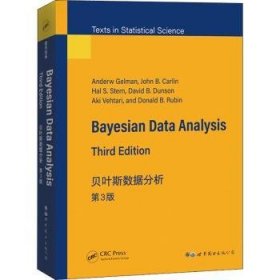
Bayesian data analysis
全新北京
¥ 104.80
-

Bayesian data analysis
全新广州
¥ 101.26
-
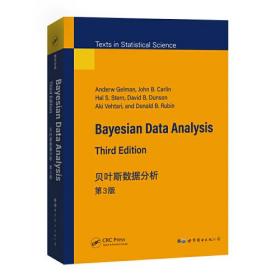
Bayesian data analysis
全新北京
¥ 160.20
-

Bayesian data analysis
全新北京
¥ 99.71
-

Bayesian Data Analysis
全新宜春
¥ 907.40
-

Bayesian data analysis9787519261818
全新广州
¥ 131.82
-
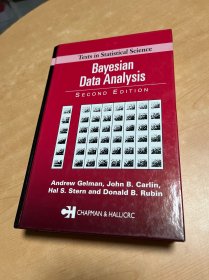
Bayesian Data Analysis, Second Edition
九品阜阳
¥ 350.00
-
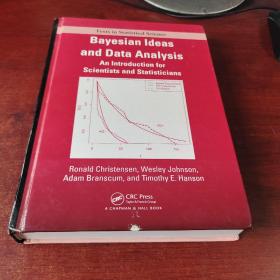
Bayesian Ideas and Data AnaIysis(如图)
九品阜阳
¥ 460.00
-
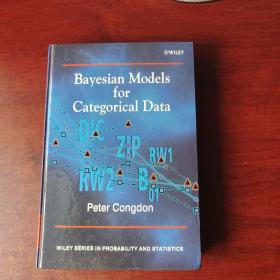
Bayesian ModeIs for.CategoricaI Data(如图)
九品阜阳
¥ 280.00
-
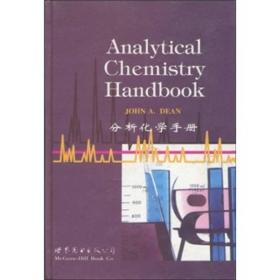
Analy
全新保定
¥ 79.90
— 没有更多了 —













以下为对购买帮助不大的评价